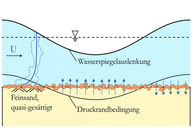
The phenomenon of soil liquefaction is a problem that occurs in different contexts worldwide. This process is caused, for example, by earthquakes or by wave action on a canal or in the sea. The consequences can be, for example, inadmissible movements of buildings, washed-out pipelines or instabilities in earth structures. This research project is specifically concerned with wave-induced liquefaction and its improved modelling. Constitutive approaches developed in the past could be used with the help of numerical methods to simulate specific aspects of the liquefaction process. However, no model has yet succeeded in adequately representing the entire process, including initiation of liquefaction, change of state and expansion of the liquefied area, sedimentation with re-increase of shear strength, renewed liquefaction, etc. In the field of rheology of granular media, progress has been made in recent years with regard to the mapping of different states of granular media, in particular also the phase change of fluidization. The aim of this research project is to examine the transferability of models from the field of rheology of granular media to geotechnical engineering and specifically to the phenomenon of liquefaction and to compare them with geotechnical modelling approaches. In a first step, different approaches from the literature will be compared and promising representatives will be selected. These are to be implemented in a numerical software. After a subsequent verification of the models, various tests carried out at the Federal Waterways Engineering and Research Institute (BAW) are available for validation.
Project period: 01/2022 – 12/2025
Project partner: Bundesanstalt für Wasserbau (BAW)